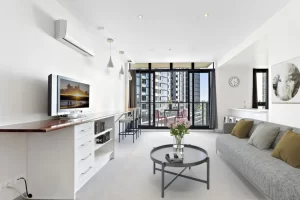Residential rents have surged to record levels across most capitals in the past 12 months with apartments in Docklands and Southbank in Melbourne jumping more 29 per cent as strong demand outpaces dwindling supply, data from CoreLogic shows.
Tim Lawless, CoreLogic research director, said the upward pressure was expected to continue in the months ahead as international migration ramped up.
“Almost every broad region of Australia is recording rents at record highs,” he said.
“Currently we are seeing the upwards pressure on rents being broad-based. However, looking forward we could see rents across the unit sector rising faster than house rents.
“This is partially due to the rental affordability advantage units have over houses; renting in the medium to high-density sector is generally cheaper, but also because we aren’t seeing as much new housing supply under construction in the higher density sector as compared with lower density housing.
“Additionally, as overseas migration normalises, it’s reasonable to expect a large portion of this demand will flow into the inner-city unit sector where rents are already rising rapidly.”
Marcel Dybner, head of property management at Besser+Co, a Melbourne-based agency, said demand around Southbank and Melbourne’s inner-city suburbs was now rising faster than before the pandemic.
“We recently had a property in Southbank which we increased 10 per cent after the previous tenant left and within 24 hours, we had over 150 people registered to inspect the apartment,” he said.
“We then increased the price by another 15 per cent and still had in excess of 60 people attend the inspection.
“We advertised another apartment for $430 per week and due to the unexpected level of interest, we increased by $50 prior to inspection and still received multiple applications.”
Mr Dybner said it was becoming common to have at least 20 groups attending an inspection and for rental apartments to receive several applications.
”We’re now seeing the flow-on effect of the increase in demand in the inner city making its way out to suburbs like St Kilda, South Yarra and Caulfield, where enquiries are starting to increase and interest in properties is picking up,” he said.
“We’ve had to hire more inspection staff so that we can offer more availability to get everyone through the properties they’re enquiring about. We now do inspections six days a week, and we’re thinking of opening on Sundays too.”
High demand
In the past three months alone, median rents for apartments in the Melbourne CBD, West Melbourne, Docklands and Southbank rose by more than 10 per cent each, or by at least $51 per week.
Apartment rents also rose sharply across Sydney’s inner suburbs such as Ultimo, Eastgardens, Haymarket, Botany and Zetland, where the median climbed by more than 7 per cent, or by $44 per week, in the past three months.
Houses remained in high demand, with Sydney’s southern suburbs Woolooware and Loftus, and Clovelly in the eastern suburbs notching more than a 10 per cent jump in average rents during the same period.
House rents rose by 9.2 per cent in Mount Ommaney in Brisbane’s west, by 9.7 per cent in West Beach in Adelaide, and by 7.9 per cent in East Perth.
In the past 12 months, median rents across Sydney jumped by 9.4 per cent, in Melbourne by 7 per cent, in Brisbane by 11.7 per cent and in Adelaide by 9.8 per cent.
Rents climbed by 6.4 per cent in Perth, by 9 per cent in Hobart and by 9.2 per cent in Canberra.
“I have not seen rents at these levels in my lifetime,” said Kent Lardner, founder of Suburbtrends.
“We have seen isolated geographical areas such as mining towns that go through this type of rental boom, but I have not seen that problem spread across virtually every suburb and region in the country all at once.”
With overseas migration picking up, demand was set to increase even further, Mr Lawless said. However, affordability might affect the rate of future rental growth.
“Rental demand tends to be less elastic than purchasing demand, probably because renters aren’t able to access credit to pay their rent,” he said. “As rental affordability becomes more challenging we will probably see a reversal in the earlier trend towards smaller rental households as renters look to maximise their occupancy in order to share rental costs.”
This article is from Australian Financial Review, please click the following link for the original article: https://www.afr.com/property/residential/apartment-rents-jump-29pc-in-inner-melbourne-20220607-p5arvk




